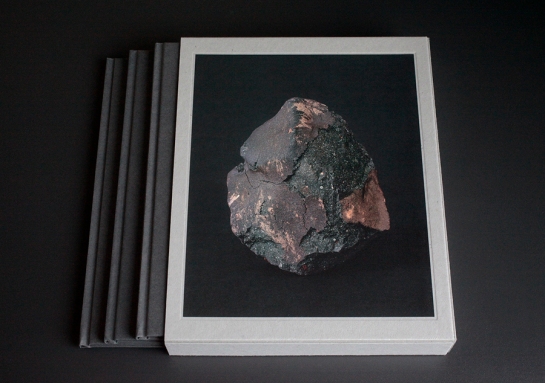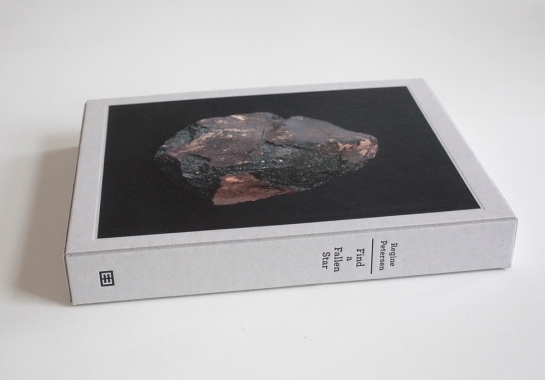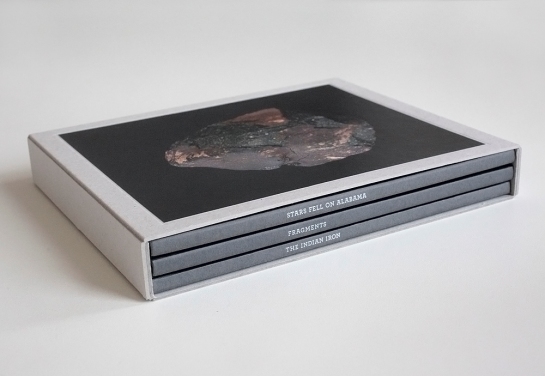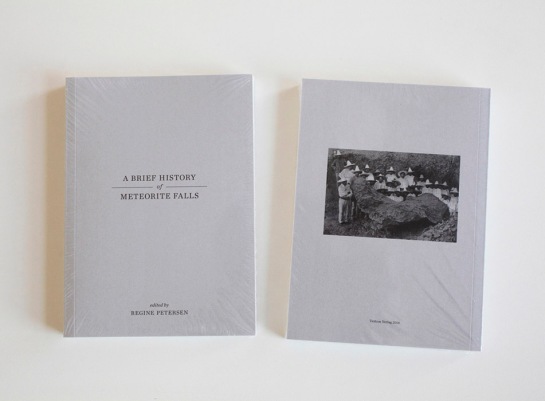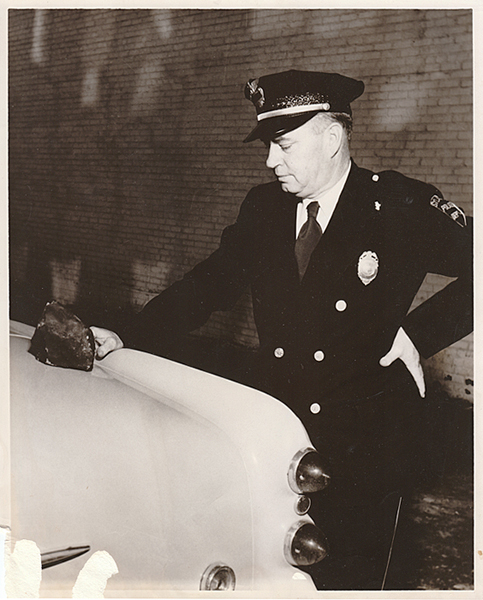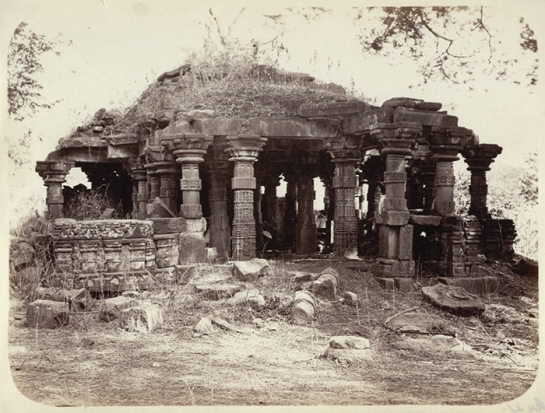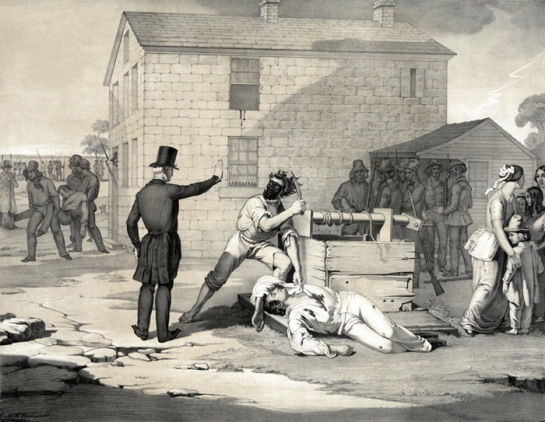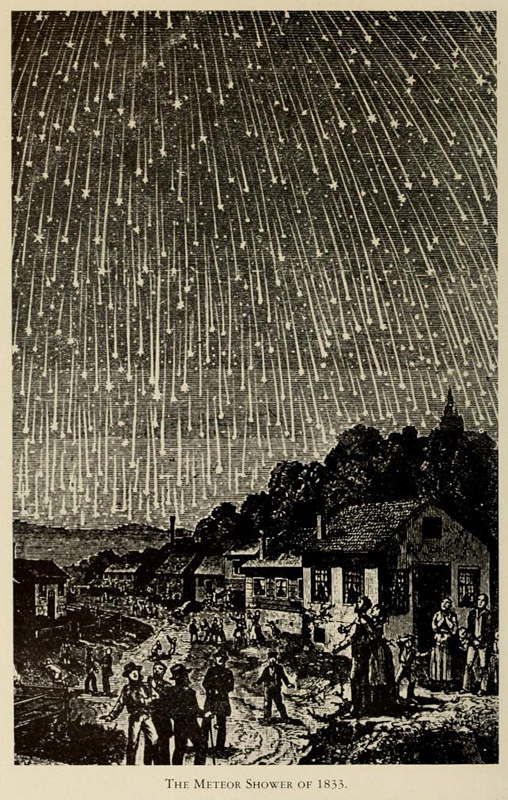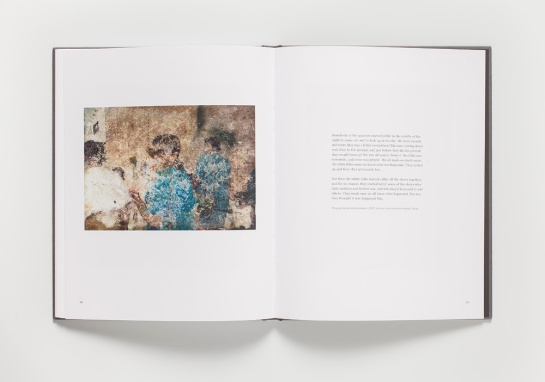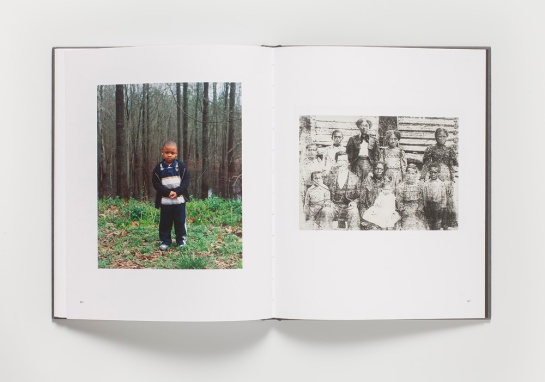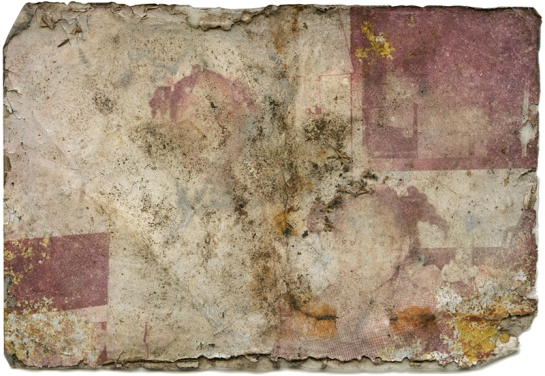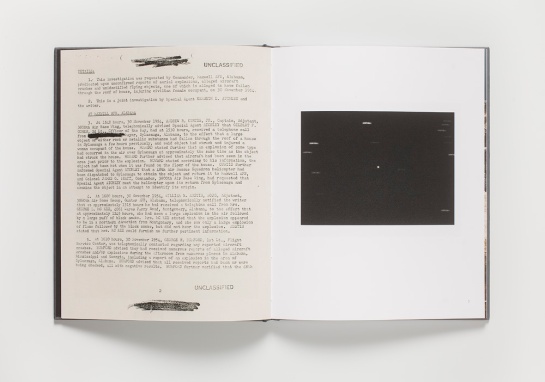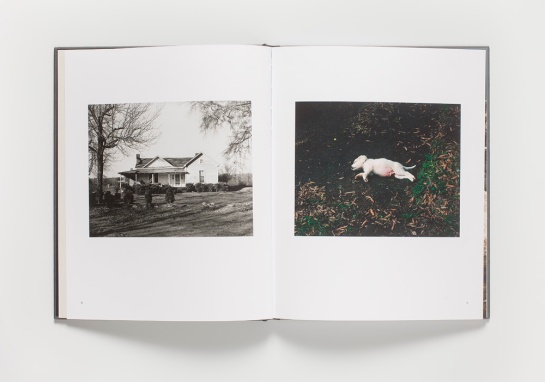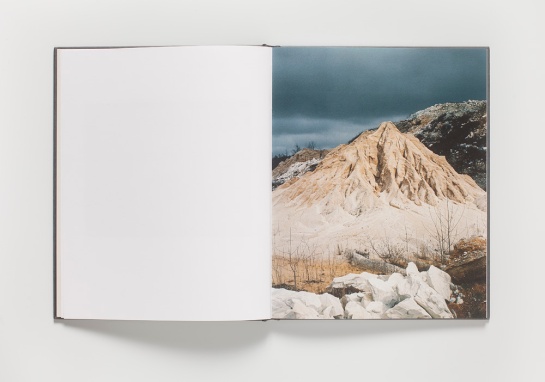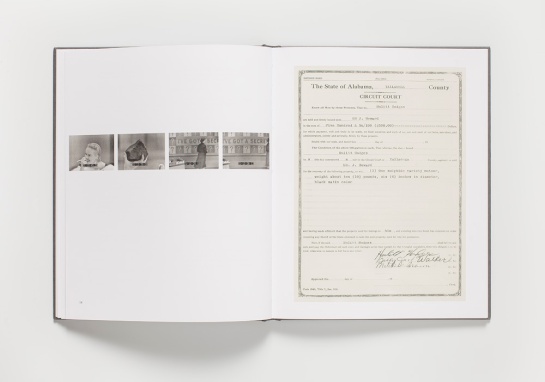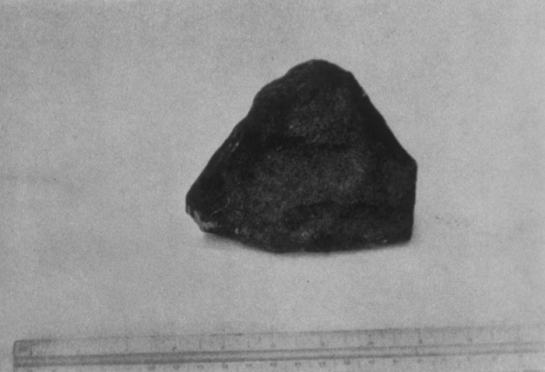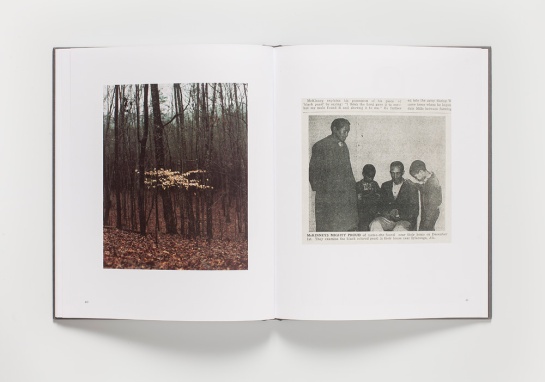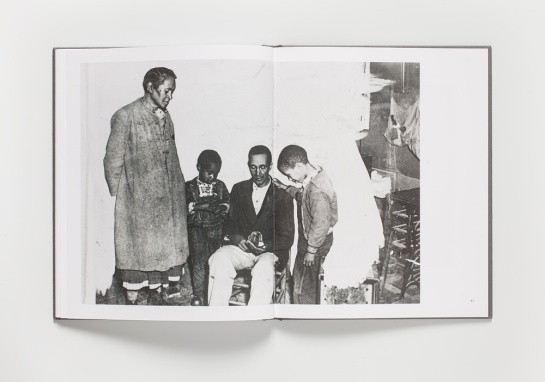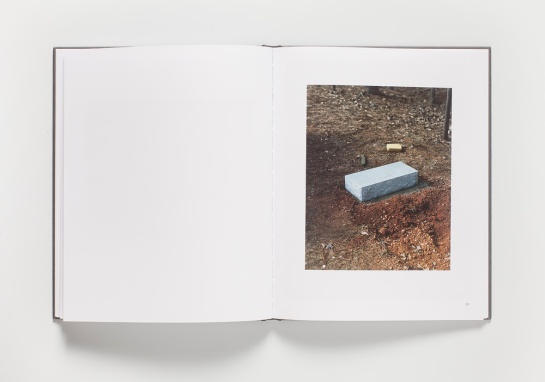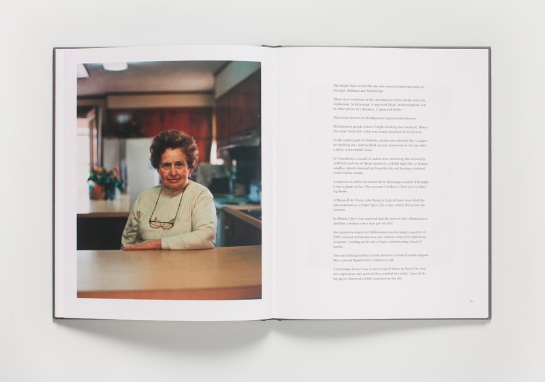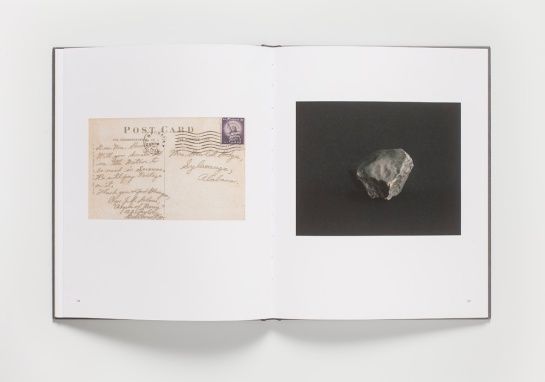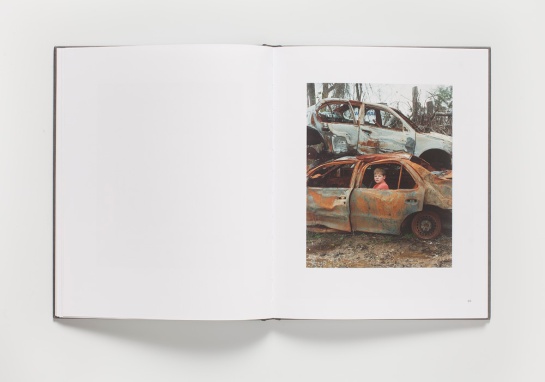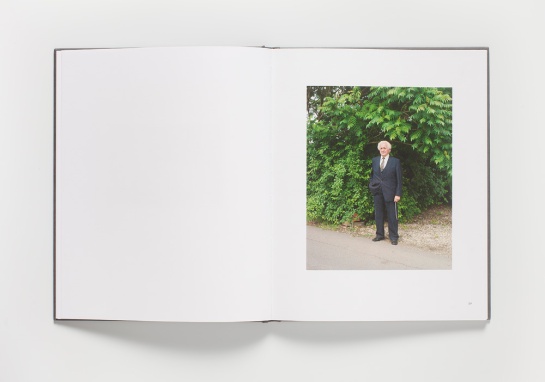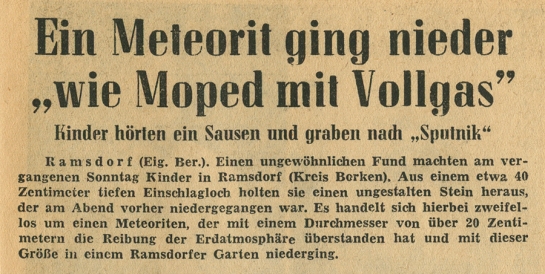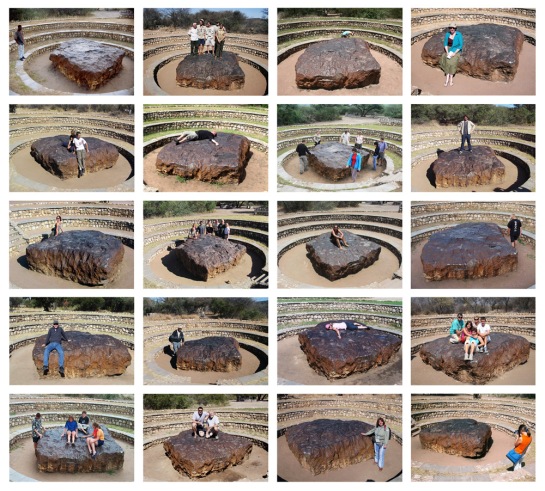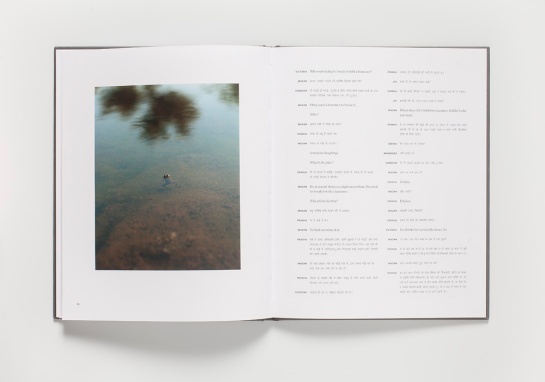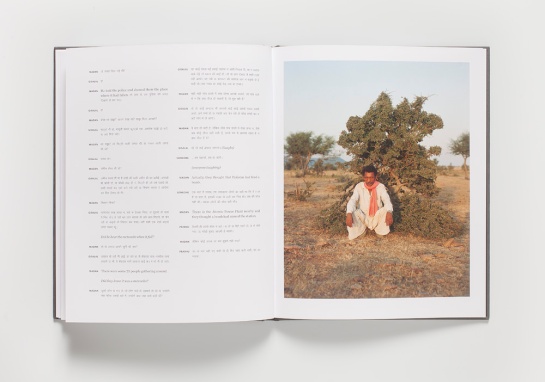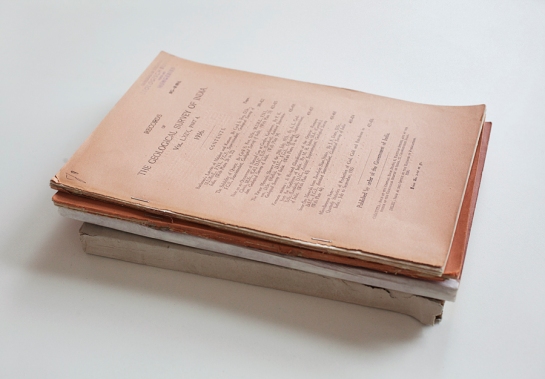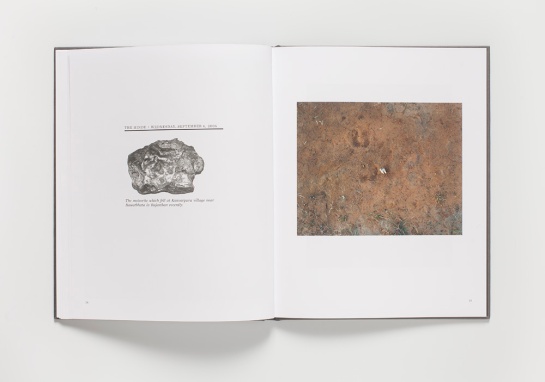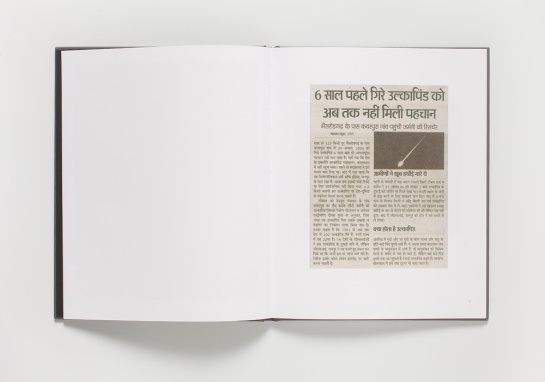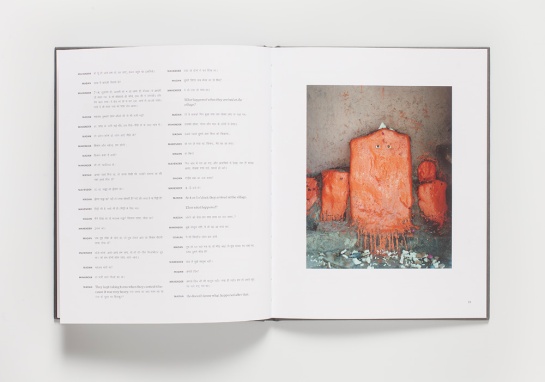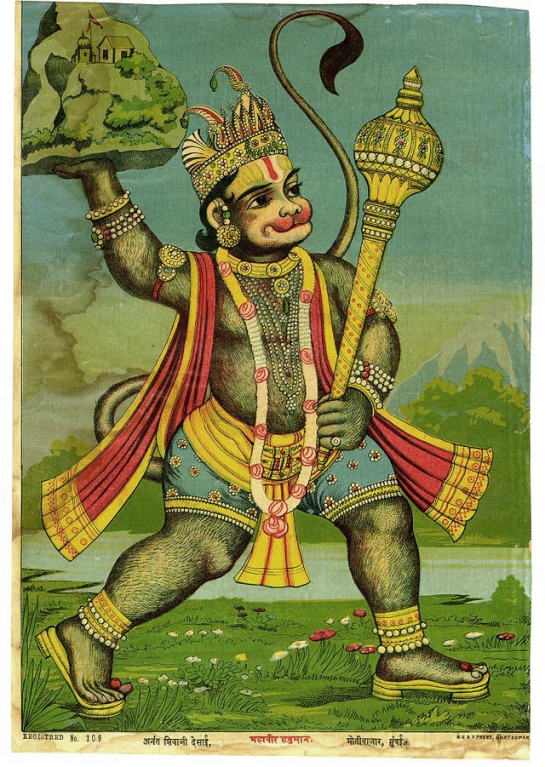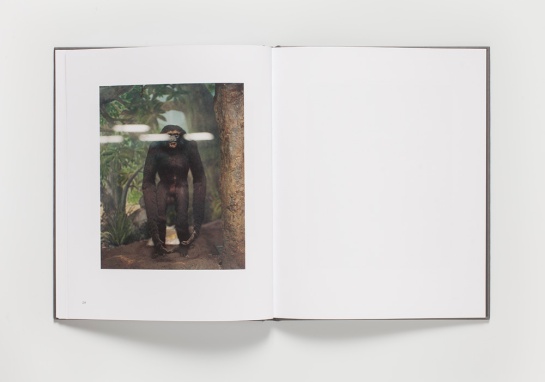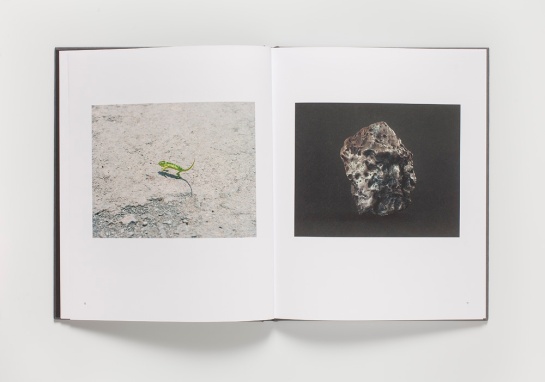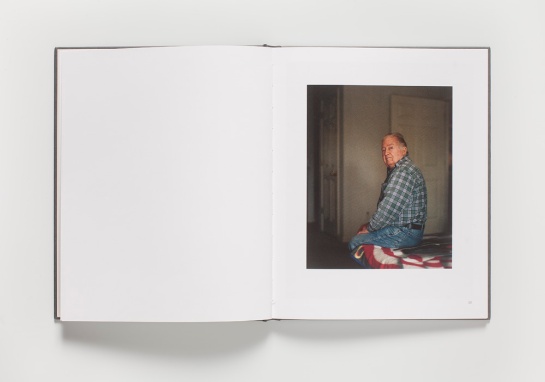IT MUST HAVE BEEN SUBLIME: “Zschhht, bumm, gone”. A conversation with Regine Petersen on her KEHRER publication in three volumes: Find a Fallen Star
Mirelle Thijsen (MT):
I have never done a preparation for an interview in this way: I was leafing through your recently published ‘triptych’ Find a Fallen Star (2015), and enjoyed the ‘narrative’, or the lack of it, so much; I like your ‘style’. I made a random choice of pages, events, names from this poetic constellation, if I may call it so, your book project Find a Fallen Star, as the narrative unfolds and I discover links between pictures, documents, oral history and events. Three cited online sources accurately explain the facts about the three extraordinary events in 1954 in Alabama; in 1958 in Ramsdorf (Germany) and in 2006 in Kanwarpura (India): printed on the inserted text document, preliminary to the essay by Natasha Christia, which addresses personal memory, myth, language, cross-temporal conversations, the fragmented world and melodrama, rather than facts. Three plain hard covers in a carton sleeve cover the uncanny stories, respectively entitled: Stars fell on Alabama (Volume I), Fragments (Volume II) and The Indian Iron (Volume III). In the back of each book, a photo-index delivers captions in keywords. First, you published a text-oriented book, A Brief History of Meteorite Falls (2014), containing a collection of 100 eyewitness accounts and little stories on meteorite falls in different countries from different time periods.
To begin, please give us a short introduction to the book you started with, about a year ago: A Brief History of Meteorite Falls.
Regine Petersen (RP):
A Brief History is a collection of texts I gathered throughout the last years of my research. I started compiling it while still working on Find a Fallen Star, because the production of the photobook itself took so long, and I wanted to do something that produces quicker results. I knew I had a wealth of material and I didn’t want to leave it in the drawer. I went through all my notes and narrowed them down to 100 stories.
MT:
Why did the other book take so long?
RP:
The photobook? It’s my first photobook and there were so many decisions to be made. But that was mostly enjoyable; the hard part was finding a publisher.
MT:
A Brief History is self-published, am I right?
RP:
I worked with a small publishing house in Hamburg, Textem Verlag.
MT:
At the time, I presume, you already had collected and compiled all the material for the photobook publication, but had not yet found a way to make it public?
RP:
Yes.
Three Stories, Three Themes, Three Locations
MT:
Let’s now get back to the subject matter. Why these three stories? Why three themes, three different locations, three cosmic events. How did you get to them?
RP:
It started when I read about the story of Ann Hodges (1920-1972) of Alabama, who was hit by a meteorite in the 1950s. When I saw the image of Ann standing under the hole in the ceiling, surrounded by the mayor and the police chief holding the stone, it somehow struck a chord with me. Anything that followed in some way deals with similar encounters of ancient rocks from space and the fragile life on earth. Meteorites were formed at the time the solar system came to be, 4.5 billion years ago, and they offer us a very different idea of time when compared to our human time scale. The Hodges story was the one that illustrated this in the most direct and obvious way, as this is the first, and some say, only documented case of a human being hit by a meteorite. I was curious what had become of her, what kind of life she lived, and how the situation in Alabama was at the time.
MT:
Where did you see that image? Where did you encounter it, in what context?
RP:
That was on the Internet, where I did my initial research. There is another, more ‘official’ image of the same situation: in that one Ann Hodges is holding the stone herself and is looking at it. It was used more widely. I think I stumbled upon that press photo first. Then I found the other picture, in which she seemed to be more in a world of her own, confused by everything that happened. She had a big bruise on her hip and her hand got hurt. It must have been a dramatic experience for her. I think that this aspect is more visible in the image in the book.
MT:
What is the provenance of both images?
RP:
A police photographer called Harmon Mims took the pictures. He is no longer alive.
MT:
For now, would you please give a general sketch of the three stories? We will come back to each of them separately in the course of this conversation. Did you then already know you were going to touch upon the other two stories? And when were you confronted with the Alabama photograph?
RP:
That was in 2009 or 2010. I started to do more research and a whole new world opened up. There were so many stories about falling meteorites out there, so many witness reports, and the fact that it happens all over the world provided a colourful picture of these incidents. There were a lot of differences in the way people reacted. There were a lot of similarities as well.
I also felt a growing fascination for the meteorites themselves. At the beginning I didn’t even know that people were buying and selling them, even on eBay. I didn’t know that there is a community of people trading and collecting meteorites. Instead I contacted NASA. [Ha-Ha.] They said No to my query! So I found out that there are easier ways to get access to meteorites. I got to know a lot of people, became part of the ‘scene’… and in the end I even worked with NASA scientists.
MT:
How long did you stay with your fascination?
RP:
How long I stayed with it? Well, I am still at it! It’s the meteorite bug: once you have it, you can’t get rid of it. [Ha-Ha.]
MT:
It didn’t stop with completing the book project?
RP:
No, No. I am working on something else now, but I will always be interested in meteorites. I used to avoid Facebook, but I have a profile now for the different meteorite newsgroups. I try to go to the fairs and I’m in contact with people. It really is of interest to me.
MT:
Let’s make the step to the second volume: Fragments. When did you decide to take the German story as a major theme? What did you find?
RP:
I’m not sure anymore where I first read about it… but I heard that five children found the meteorite, they broke it into pieces and shared it among them, secretly. Someone got me in touch with the main eyewitness, Luise, the daughter of the village doctor.
MT:
Karl Meisohle…
RP:
Yeah, and I called her. She told me about some recent tensions between the people that initially witnessed the fall in the 1950’s. Back then Luise’s father took the meteorite fragments from the kids, for which he gave them 10 DM each; you can see the contract he set up is reproduced in the book. And I think, in hindsight, some of the children weren’t happy with the deal. I call them children, but now they are of course grown-up people! Some of them regret giving their piece of meteorite away. And it turned out that one of them actually kept a piece…
After I spoke to Luise I wanted to talk to the other witnesses as well. And I found them, one by one, and their testimonies were strikingly different. Each and every one of them told me a different version of what happened. Also, there were more and more people in town who claimed that they had been part of the story. It is interesting to look at the way things are remembered, and how stories and histories are being constructed, not just by these people but by all of us. There are always many perspectives on one and the same thing.
MT:
Exactly. To get a taste of it all, let’s move on to the third story The Indian Iron: When and where did you find it? Why did you choose it, in general?
RP:
I went to India several times. First I did some work at Lonar crater in Maharashtra and I included some of those images in the chapter. It’s a beautiful place, a unique ecosystem created by a meteorite impact tens of thousands of years ago. The crater is now a circular lake with a little jungle around it. There are also a lot of temple ruins around this lake. But I also did research on smaller witnessed falls in India, and found that there were many of them because the country is so densely populated. All three stories in the book have religious aspects, and in India it is so obviously different than in the other chapters.
MT:
You mean Buddhism, in India?
RP:
No, Hinduism…mainly. At some point I came across a newspaper article about the Kanwarpura meteorite fall of 2006 in The Hindu newspaper. It said that two shepherds had seen a meteorite fall, beat the meteorite with sticks and immersed it in water. I immediately thought there was some kind of superstitious motive behind it. When I got there the story was in fact totally different. The witnesses had been pushing the meteorite with sticks simply because they thought it was hot, and dumped it in the water to cool it down.
MT:
Interesting, this whole project is about truth.
RP:
Yes.
MT:
Let us first look at volume I, which you just now called a ‘chapter’. Is that how you deal with the stories? Do you rather see them as ‘chapters’ than ‘volumes’? I considered them different books.
RP:
I say ‘chapter’, but it is something in between. My first dummy had all the chapters in one book. It didn’t work. I wanted to keep the stories separate but also somehow connected, so eventually I decided to put three books in a slipcase. You may call it ‘volume’ or ‘chapter’. I don’t care.
MT:
Let us now look at volume one, or chapter one. Stars Fell on Alabama (the title refers to a jazz song composed by Frank Perish…
RP:
It’s the wrong name. It’s a mistake in the book.
MT:
Pardon?
RP:
He is called Frank Perkins. And the lyrics are by Mitchell Parish …
MT:
I did find it on Spotify anyway! I considered it a nice footnote, in terms of the information.
And the origin of that song is an earlier cosmic enigma in Alabama, called: the Great Leonid Meteor Shower, that took place as early as November 1833 and was only visible in the south-eastern part of the United States, I read in a endnote of the essay by Natasha Christia. There are two versions of the song: by Doris Day, and Billie Holiday. You refer to that cosmic event in a text fragment from the personal journal, or logbook, by Prophet Joseph Smith. I think this makes it all so interesting: all these names that pop up, they are like actors! Volume I opens with that statement. My question is: Who is that Prophet? He talks about ‘fireworks of eternity’ to ‘entertain the Saints’ and ‘awe the sinners’.
RP:
I think he is a self-declared prophet! And he is actually the founder of Mormonism in America. He founded the Church of Jesus Christ of Latter-Day Saints. Joseph Smith talks about ‘sinners’ in that text fragment. Ten years later, in 1844, he was killed by a mob. You’re right about the names, they have a kind of poetic sound to them; I really like to work with the way a name or a text looks and sounds, how it works on the surface, how it becomes an image.
MT:
As a component of the narrative, I understand, it’s very clear. I looked at specific pages in the book, and consider it helpful for the reader that we number them in our conversation, so they can easily be found.
Not only at the beginning of the book, but also in the very back of the publication, (I, 49) you included a religious component, if I may call it that, an oral account by Amanda Young regarding The Great Leonid Meteor Shower of 1833. It is about belief, racism, and fear of death, truth and Judgment Day. Where did you find this document? And who is Amanda?
RP:
Amanda Young was a slave. It is an account I found on an African-American history website. It’s a vivid memory of someone who was 7 or 8 years old at the time and listened to his great-great-grandmother. She was not a prophet or a historical figure.
MT:
How has that oral personal account been ‘preserved’?
RP:
The memory was passed down in the family, as an oral account. This is a contrast to the written ‘historical document’ from the beginning of the chapter. Perhaps things got lost in the process of re-telling the story, but the Leonid meteor shower of 1833 must have been a truly impressive event, probably the most amazing spectacle that modern man has seen in the night sky. People had difficulties expressing what they actually saw, because it was so beautiful, terrifying and sublime.
MT:
Juxtaposed to that account is a scattered colour photograph showing members of the McKinneys family? And on the recto (I, 47) is a black and white group portrait of the McKinneys from the1900s, showing in the front row: Otha, William, Mary, Claude, Josephine, and Julius. In the back row: Thomas, William, Mary, Mattie and somebody unknown. How does the colour photograph relate to the black and white group portrait? And who are the McKinneys?
RP:
Julius McKinney was a black farmer who found a second piece of the meteorite the day after Ann Hodges was struck. He was out with his mule to get firewood and found the rock on a dirt road. This is the same place where I photographed the bottle on page 39. As you can see, the road is still a dirt road. I got to know some of Julius’ grandchildren and they gave me some documents. Among them was a photograph of Julius’ father. I was surprised that he looked kind of white, and I asked the family about it and did myself some genealogical research. I learned that during plantation years, there had been complex relationships in the McKinney family between slaves and (married) slave owners. Several children came out of that relationship. Julius’ mother was dark but his father was, to put it that way, three-quarters white and one-quarter black. Yet he was still considered a black person. We know this from Barack Obama, who will always be considered black, even though he is half white. We have these categories for people; and I actually became more aware of my own whiteness, which is something that, most of the time, is invisible to me. I kept thinking about these things a lot. So I included the family photo with Julius’ more or less white father, and Julius himself is in it as a boy, standing on the far right.
MT:
He is the finder….
RP:
Julius is the one in the image of the newspaper clip and in “The Negative” on page 43, holding the meteorite. He was able to sell the rock, so his story had a happy ending, other than that of Ann Hodges. He was able to buy himself a used car and new property. That’s where I found the other image you mentioned: the decomposed photograph on page 48. On the land, there was a burned down trailer from one of Julius’ daughters, which had been abandoned for years. I found several photographs in there, which had been damaged by fire, by water, by mud. I scanned these images, enlarged them to see the fissures and grass and dirt, there was even a little insect under the top layer of the photograph, which had peeled off. It is all surface and the information of the image is lost. I like the materiality of it.
MT:
Definitely.
RP:
For me, there is a complexity here. I cannot access the whole story. These people had their private lives, something I know nothing about. I look at it from a certain perspective, from my point of view. At the same time, I want to visualize this gap, to show that there is another history below and beyond the surface of the image.
MT:
Thank you, that’s very clear. What kind of ‘unclassified document are we looking at here (I, 6)? I would call this a ‘forensic’ document, in a way. The text is also interesting in terms of grammar. Details are numbered and described, I quote the first ‘DETAIL’: “1. This investigation was requested by Commander, Maxwell AFB, Alabama, predicated upon unconfirmed reports of aerial explosions, alleged aircraft crashes and unidentified flying objects, one of which is alleged to have fallen through the roof of house, injuring civilian female occupant, on 30 November 1954.” My question is: And how does this declaration relate to the following four images in Volume I. I mention these titles explicitly because they are short, accurate, like in a police report, and sometimes funny. And representing nothing more than necessary: (I, 7) Parent Body; (I, 8) ‘Hodges House; (I, 9) Dog (Impact Site #1); (I, 11) Sylacauga Marble City.
RP:
The provenance of this document is ‘Project Blue Book’, which used to be a program of the U.S Government to investigate UFO reports. These were classified documents at the time, now de-classified.
MT:
Why did the document change status?
RP:
Because the incident was proven to be a meteorite fall. At the time the United States Air Force didn’t know what it was and confiscated the rock. It could have been a Russian bomb or a flying saucer.
Some choices I make are formal choices. I like the juxtaposition of the document and “Parent Body” (I, 7-8), because they almost look like reversed versions of one another, the crossed-out black text seems to be echoed in the white lines of the moving stars. The document attempts to describe everything in a formal and objective manner, and then there is this mysterious object in the night sky we know nothing about, or a mere representation of it. It’s just a pixel in the dark! It’s an image of the supposed ‘Parent Body’ of the meteorite. It is an asteroid named 1685 Toro. Scientists calculated the orbit of the meteorite, and they assume it came from there. But they’re not certain.
MT:
Really, this is its location in space? That little thing?
RP:
It’s one of the two images of the asteroid in existence. They were taken by David Richards, an amateur astronomer from Aberdeenshire, who allowed me to use the image. One has to believe in this thing being out there in its orbit; otherwise the image doesn’t provide any information.
MT:
We always need some visual proof!
RP:
The name ‘Parent Body’ obviously has a ring to it, which allows different interpretations. I’m interested in the idea of distance and closeness: These images somehow come together in that way. The image is followed by a picture of the house of the Hodges. The photograph of the dog was taken where the house used to be. It burned down; many houses in Alabama do because they are made of wood. It has been replaced with two trailers.
MT:
Is the little puppy dog alive or dead?
RP:
It’s alive! Many people ask me that. It’s just sleeping.
MT:
And finally, please comment on the picture (I, 11) Sylacauga Marble City, the landscape?
RP:
Sylacauga is also called ‘The Marble City’. There are many marble quarries, some of them no longer in use, like the one on the image. Marble from Sylacauga has been used to build several monuments in Washington, for example. There is a relationship to the unclassified document we talked about earlier. But this is a connection I just made right now, talking about it. Many of my decisions are intuitive; I make certain associations while I’m taking photographs, others during the editing process, and some connections appear to me much later. So when you talk about certain aspects of my work, I might learn something new as well. It’s a nice experience.
MT:
It is very interesting: a moon landscape in itself, like an undiscovered planet. You visited a second Impact Site #2 (I, 39) of the meteorite, and photographed a bottle. You yourself classify pictures and documents, in a way, and numbered them, too. Also some of these echo in the book: McKinney Trailer Find #4 (I, 48); and Lawsuit #3 (I, 19). Why? And what do the numbers refer to? Maybe it’s an open door, but still I would like to know….
RP:
Yes, it is an open door to the fact there is more than one; I made several finds in the trailer, and I may use other images than the one in the book, in exhibitions for example. Same with the ‘Lawsuit’, Ann Hodges’ husband, Eugene, was a little ‘ill-tempered’, as Natasha Christia put it in her essay of the book. He wanted to make profit from the rock that fell on his wife, and of course claimed it as his own. But the mayor allowed the Air Force to take away the meteorite. So Eugene sued the mayor. Then there was Birdie Guy, the landlady of the property and the mother of Ed, whose picture is on page 13. She claimed the meteorite for herself, because it fell on her house. So there came another lawsuit. There had also been discussions with the lawyer of the Hodges to sue LIFE magazine because they had published an unauthorized photograph of Ann lying in hospital. People in town ridiculed her because of that image, because it showed the bruise and quite a bit of bare skin. But Ann herself was taken by surprise in that moment; the doctor had just lifted up the bed sheet for the journalist who quickly snapped the photo.
MT:
You’re revealing a much deeper story. So if I understand it well, you don’t always show the whole series of documents in the book? It’s not meant to be undivided.
RP:
Indeed.
MT:
What does ‘The Negative’ refer to (I, 42-43), which is also in itself a beautiful title? I understand it shows the McKinneys around 1900….
RP:
No, that’s actually the one on page 47. ‘The Negative’ is from the 1950s.
MT:
Oh, yes, the newspaper clipping, I mean the image on page 41.
RP:
It is the McKinneys, I agree on that!
MT:
It is such an interesting scene, everyone is looking down, and there is something humble in there. Also reflected in the position of the boy with his right hand on top of his father’s shoulder. It feels like something tragic…. Here we see a poor black family looking DOWN, really, at an odd object in the left hand of father McKinney sitting in a chair. I read ‘mighty proud’ and ‘black pearl’ and ‘found by a 60-year old Negro farmer’ on (I, 41) a newspaper clip echoing ‘The Negative’, of the same picture, printed on the next spread, and all related to: ‘a fragment of the same shooting star that struck Mrs. Hewlett Hodges (the first human being ever hit by such a missile from outer space).” And then that part of the meteor was sold to Stuart H. Perry, publisher of the Adrian Michigan Telegram.
RP:
You spotted that so well. The words that were used at the time are remarkable. You can read a lot into them and between them, they tell so much about the contemporary situation. It was a time before the Civil Rights Movement, and Julius McKinney was afraid that the meteorite would be taken away from him. At first he kept his find secret. The only person he told about it was the postman who arranged for a geologist to look at the rock. In the end he was able to sell it and make some money from it.
MT:
How much?
RP:
I don’t know. It wasn’t documented.
MT:
Sold to Stuart H. Perry?
RP:
Yes. The document says the ‘purchase price was not disclosed’, but it certainly was a lot of money for the McKinneys. When you look at page 41 you can see part of the only bigger newspaper article that was published about the McKinney meteorite. The image is cropped; I later saw the original negative, Julius’ granddaughter showed it to me, and it is printed in the book on the following double pages (I, 42-43). It shows that the background had been painted over. In those days negatives were retouched in this way, and you can see they did not paint the negative all the way. On the right hand side you can still see the original background, and the poor conditions in which the McKinneys lived. We don’t really know why it has been painted over: Was it at the McKinneys’ request? Was the background simply too distractive? Was it censorship? I would say it has been ‘blackened out’, but it is quite the opposite: it is ‘whitened’ over. They were also a humble family, and sceptical towards white people coming by and asking questions.
MT:
It brings us to the quote, and related to that is the striking picture of the vulnerable mule (I, 36): “the mule found it and showed it to me”, said McKinney. It reads like a phrase in a poem; it’s about the essence of life and being humble again: ‘I didn’t find it; it was given to me’. It has a spiritual connotation. And this cute animal: where did you find it?
RP:
It was standing on a pasture. There are many mules and donkeys in the area. Even at the junkyard, where I photographed the boy in the car wreck (I, 23).
MT:
I wonder if you already had read about the mule beforehand; did somebody tell you about the quote? Was there a link already with this particular historical document, before taking the picture?
RP:
In that case, yes.
MT:
And ‘Eugene’s Grave’ (I, 33), you’ve just introduced him: he is the husband of Ann Hodges. But I don’t understand the picture with the caption. Is it his grave?
RP:
Yes. Eugene died two weeks before I came to the U.S. at the age of 89. When I was in Alabama I decided to go and find his grave. I went to this small churchyard. There was nobody there, and I saw a fresh grave. Exactly at that time two workers came up in their car and started to assemble the gravestone. They started with the base, and this is what I photographed. Then they put some glue on top of it and mounted the tombstone. So this is the moment just before that. It was a weird situation. No family members were present. Eugene only had one son, but not with Ann Hodges. I don’t know whether it was disrespectful to take a photograph at that moment. There was, in any event, something sad about the situation.
MT:
The picture says it all. That yellow object in the picture looks like a bar of soap!
RP:
That’s a sponge.
MT:
And we have eyewitnesses of the cosmic event. Where did you encounter the ‘Eyewitness’ (I, 35)? Apparently more than one: A waitress; a Maxwell Air Force pilot – flying at high altitude; two men fishing in Paint Creek; a Sylacauga farmer. Please tell me more about these witnesses.
RP:
I haven’t met them. These testimonies are assembled from various sources. A report from a geologist, people’s personal files, other sources: many reports, found partly online, but mostly on paper. There is an archive at the Alabama Museum of National History, I got several documents from there, the postcard that was sent to Ann Hodges for example, papers from Ann’s lawyer. I also got a lot of material from a researcher, John C. Hall from Tuscaloosa. He is the most knowledgeable person about the Sylacauga meteorite, and he helped me a great deal.
MT:
It’s an impressive archive. And did you make a selection yourself from the existing documents and from the eyewitnesses’ accounts?
RP:
Yes.
MT:
And who is the person portrayed on the left page (I, 34)?
RP:
I tried to find Ann Hodges’ second house, the one she moved to after she divorced her husband. I couldn’t locate it, but I roughly knew the area. So I knocked at someone’s door. People were always very welcoming and the lady invited me in. She told me that she once shared a room with Ann in the hospital.
MT:
A more informal testimony… and not mentioned in the personal accounts written out on page 35.
RP:
No. To me her gaze is interesting. She seems very adamant. I found her portrait nicely contrasted with all the different descriptions and perspectives on the opposite page.
MT:
Now let’s look at the postcard you just mentioned. I read a hand-written note on the back of a postcard (I, 28). A reverend asked Mrs. Hodges “to donate the meteor to be used in sermons. “We will pay postage on it”, he suggested. A strange request, quite extraordinary, is it not?
RP:
I have another document for you, which I didn’t use in the book:
MT:
Incredible, lets illustrate this post with some of these unpublished documents. So where did you actually find the postcard? And what do you think of the reverend’s request? He wants to use the rock for his sermons and is willing to pay for the shipping!
RP:
He is being generous! It gives a feeling for the many absurd reactions towards these phenomena and the religious connotations that come with it, all over the world. Ann Hodges received many religious letters. People thought it was a sign from God, and before things took a bad turn for her, Ann Hodges said herself: “God sent it to me”. Julius McKinney said a very similar thing.
MT:
So there are these connections again, also within the storytelling, such as the religious component.
RP:
Yes.
MT:
I would like you to comment on a young boy photographed at Merkel’s junkyard (I, 23) while sitting in a rusty car wreck. This is close to one of the impact sites? Is that correct?
RP:
Most of the images are quite close; it’s a small community. But I take my own liberty to photograph anywhere I want. I went up North of Alabama as well to visit the U.S. Space & Rocket Center and Ann Hodges’ grave near Huntsville, and I took photographs on the way. But the boy was living close to the fall site. His last name is Merkel. I came across many German names in the region. Many of the inhabitants are descendants from Germans settlers. There were roads with my name as well: ‘Petersen Lane’ for example. And this boy happened to have the same name as the German Chancellor. His uncle was the mayor of the town, and his father owned the junkyard. There is a reference to the German chapter, but mainly I was just interested in this junkyard. It was such a pleasure to take photographs there.
Fragments
MT:
It’s a great picture. I am going to now close this book, and pick up Fragments, and continue with what you call Chapter two and I call Volume II. Let me now ask you a series of questions related to Fragments. In terms of timeframe, this is just four years later: a meteorite fell on Ramsdorf in Germany and caused ‘einige Probleme’ as reported in a special edition of Die Sterne (Zeitschrift für alle Gebiete der Himmelskunde) in 1959. The name of that magazine in itself is amazing, in this context! What problems is Die Sterne referring to?
RP:
It refers to scientific problems referring to observations during the fall of the meteorite. It seemed unusual that none of the witnesses heard an explosion. I made a couple of notes here… let me check those: There was no thunder. So now the assumption was that it must have come down at low speed, or at a shallow angle. The text also states that no light was observed. But I actually did speak to a witness who said she saw a red tail in the sky. Perhaps nobody spoke to her at the time. Those are the ‘problems’ Die Sterne is referring to, but for me, the problems in the story are of a personal kind: the apparent contradictions and tensions when looking at the testimonies of the witnesses.
MT:
Yes, especially in this case. We will get to these witnesses later in this conversation. Let’s first look at the very first picture in this book. It’s quite intriguing. I see a white tablecloth, a left-hand fist of a married woman, a beige coloured, could be leather, small casket, opened up and showing inside, probably, a fragment of the meteorite. It all makes it look very valuable in this way. What are we looking at on the frontispiece?
RP:
If you look at testimony on page 46, or read the translation…I don’t know, do you speak German?
MT:
Yes, I read German.
RP:
On page 46 you can read what Oswald has to say. He mentions that somebody in Ramsdorf still has a piece of the meteorite, but he is not allowed to tell who that person is. That was not a very satisfying answer for me, of course, and I quickly found out who that person was. I photographed the fragment, but kept the owner anonymous. It is a man. You see a man’s hand. It’s interesting though that you see it as a woman’s hand; it makes it more mysterious.
MT:
All right, this is the very opening of the book: HERE is the extra piece: nobody knows about it. Wow!
RP:
Yes.
MT:
As we move on, we read an accurate description of the fall and recovery of the meteorite, typewritten in Natur & Volk (I, 8/9). Where did you find this document? And what kind of publication is this?
RP:
Natur & Volk is also a natural science publication such as Die Sterne. The writer of the article, Dr. Mosebach, established a good working relationship with Dr. Meisohle, the village doctor who made the meteorite fragments available to scientific institutions. Meisohle got the draft of Mosebach’s article before it got published. Some words got crossed out, and corrections were made. I got the documents from his daughter Luise.
MT:
Do these materials originate from his personal archive?
RP:
Yes. His correspondence and other files…
MT:
Ok, thank you. Who was this group of young people and children that suddenly heard a noise? I think it is very interesting the way people express what they have witnessed, or explain in words the sounds, in all three cases. I kind of looked for that as well. In Ramsdorf: “like an incoming small propeller plane” on the evening of a sunny day. So we have a picture of what that is like. And this one is most incredible: “Zschhht, bumm, gone”.
RP:
Very different from the description in the Indian chapter.
MT:
This one reads like a text balloon in a cartoon like Lucky Luke! So, who was this group of people? Please give us an initial impression. We will speak in detail about several protagonists later on.
RP:
It is not clear based on the scientific text. They don’t mention anyone by name, except Luise, the daughter of the doctor. It is not confirmed who these five witnesses actually were. I know that Horst was one of them, I know Franz was one of them, but there are also people who say Horst wasn’t there when it happened. But I am pretty sure he was. Probably most of the witnesses were somewhere in the vicinity of the fall site. Some say that no girls were present, only boys. Some mention many witnesses, others only one or two. Some seem to be excluded because they were not part of a gang.
MT:
We go into the story now. This group of kids did not tell a soul about their discovery, and went back the next morning to the site and broke the thing in 5 pieces (one for each of the children). How they did that is explained as well: ‘with one blow from the back of an axe’. A nine-year-old girl, Luise, went home to tell her father, medical doctor Karl Meisohle, which led to the recovery of the ‘scientifically valuable find.’ The father assembled the other four pieces to its ‘original shape’. And then it is described as a sharp edged rock, which is smooth and the edges are blunted. And I wondered right away: Have you seen it?
RP:
I have seen the meteorite in photographs as an assemblage of pieces. On page 41 you can see a picture. Nowadays the pieces are separated and in museum collections. I photographed two of the fragments at the collection of the Arizona State University in Phoenix; the image is on page 15. I also photographed a tiny crumb at the American Museum of Natural History in New York. I initially wanted to photograph as many pieces as I could, but it was an impossible task and way too expensive. I have seen some pieces in a private collection, and of course the secret fragment we talked about. The initial mass of the meteorite is completely in fragments.
MT:
How did that happen? After the rock was collected by Dr. Karl Meisohle?
RP:
The children had already broken the meteorite apart. And scientific institutions don’t need an entire rock for research purposes. There was one museum that wanted to display the whole piece, but Meisohle preferred to give it to different institutions, so it would be analyzed. He broke it further apart in small pieces, and gave them away without charge. Later on he traded them for other meteorites and started his own little collection.
MT:
You just mentioned how to identify this group of young people. We have several portraits in Fragments, of Franz; Ferdinand (an eyewitness paving the road on the day it all happened); the five boys: Helmut, Willi, Horst, Reinhard and Ludger; a boy holding a homemade ‘Sputnik’, I guess; Oswald; Luise and Karl (Meisohle). What is the relationship between these people?
RP:
That is difficult to summarize. All of these children lived in the same neighbourhood. Some belonged to a group of friends or siblings, others were more separate. The youngest was 9, the eldest 17 years old. There is a complicated web of inclusion and exclusion. Some of the witnesses became estranged from one another; some were annoyed about Luise’s father, because he took the pieces away from them. Others think it was okay: he made them available to science. And the question is now: what to make of the testimonies? They all say different things. Memory is complicated and so are historical accounts. Everything depends on perspective.
MT:
The people mentioned in the book, are they all eyewitnesses?
RP:
They claim to be. Except for Oswald; he said: “I wasn’t there.” He also said: “I know exactly what happened.”
MT:
I thought this was interesting: first I saw the image, and then I saw the quote. And I thought, yes, this is how things are related as well.
RP:
Which image do you mean?
MT:
Page 13: ‘Smoke’. I did not get it first: Why do you need ‘smoke’ in this story, I wondered. What does the ‘Smoke’ (II, 13) refer to? Then, I read in a testimony: ‘Smoke rising from a hole in the potato field’… It is a wonderful phrase, again, like a poem. And I realized, this is a phrase you ‘drag’ along, in your mind, in your research, during the time you read and search. Just now I realize ‘smoke’ might relate also to the moment the rock of outer space is coming down, and penetrating the earth: creating a lot of smoke and dust. What is your reaction to these multiple meanings?
RP:
It is also a child’s memory in a way; things seem to be bigger than they are and get even bigger over time: the memory of steam or smoke rising from a hole. It is a strange observation, because usually meteorites don’t give off smoke when they impact the ground. That happens much higher in the atmosphere. But some of the witnesses speak of smoke; maybe it was dust from the soil. I don’t want to claim there was no smoke, but it couldn’t have been a large amount.
MT:
Regarding the photograph itself, the one you made of a huge cloud of smoke: Did you encounter a farmer burning a pile of wood, or so?
RP:
Yes, people in the area were burning stuff in their backyard. And there must have been something toxic, or chemical in there… it made the smoke very dense and smelly.
MT:
There are different interpretations of the event; oral history doesn’t always ‘match’. That is a wonderful component, and one of the multi-layered aspects, of your research project, Regine. So to make it a little more explicit I selected four non-matching observations. A) Ferdinand, living close to the Meisohle family, reports that Karl Meisohle ‘dug out the rock’ himself. B) Luise mentions another girl, Gisela, and the boys went to church before they shattered the rock. C) Franz ‘saw it happen’, and ‘smashed it with a hammer’. Another ‘object’ is mentioned and another person claiming to be an eyewitness, but he is not in the portrait of the 5 boys. D) Willi says they skipped church on Sunday morning. I guess, my central question regarding the whole project Find a Fallen Star is the following: What is ‘truth’ according to you in this context? It‘s like this is the main issue.
RP:
Yes, what is the truth? When I was speaking to the witnesses, I believed every single one of them; except for Oswald maybe… he wasn’t present on the site. On the other hand he was the one who told me about a secret fragment, and it existed. Every time I spoke to a witness I thought: this must be the proper version of the story. They definitely believed in it. Maybe they are selective in the way they see things. For example, Luise mentions that the boys went ahead and the girls had to stay behind. Do men write history because they get there first? Or did Luise take centre stage because her father was an important man in town? The boys might have completely forgotten about the girls because they were in a group, doing the hard work digging out the meteorite from the ground.
MT:
In the very moment.
RP:
Yes. So, it’s an image that they carry with them, in their mind. And even those get falsified over time. That is what happens with history as well, what we call ‘history’. To me ‘history’ is a word, too big of an idea.
MT:
It’s an ‘interpretation’ of events; a collective interpretation. And more than that, you might also call it ‘propaganda’.
RP:
Yeah!
MT:
And who is Gisela?
RP:
She really vividly remembers this event. Then again there must be some exaggeration because she explained the meteorite fell right next to her. And I think, this cannot be true. On the other hand I don’t want to be disrespectful, because I think it is just a very human thing to exaggerate. It was difficult for me to walk a line between making the representation of history an issue and not discredit the personal memories. People remember different things and those memories have value and should be allowed to coexist. I don’t want to pretend to have found the one true story.
MT:
We come to the different explanations, be it an axe, or a hammer, for example.
For now would you please comment on this quote by Luise: ‘those were the days of the first unmanned rockets, when the Russians were sending these dogs into space”. We all have a picture of that timeframe. And what did it mean for you, this quote?
RP:
It made me realize: of course, people hadn’t yet been on the moon. The way people saw the world must have been very different. Those were the days of the Sputniks, and chimps and dogs got sent into space instead of humans. I grew up with an image of the earth seen from the surface of the moon. These images gave us a different perspective on the world and on our society. Find a Fallen Star is about changes of perspective. Just as a meteorite can be looked at from different angles, depending on whether you are a religious person, or a scientist, a geologist or cosmologist or if you desire this meteorite to be in your collection, or…
MT:
A citizen!
RP:
Yes! So I really felt how different life must have been in the 1950s, the Second World War had been over for just a couple of years, and people hadn’t set foot on the moon yet. There are quite a few chimps and monkeys in these books, and there is also a little space capsule in chapter two on page 25, in which a chimp got sent into space. I photographed it in Alabama, in fact.
MT:
Did you take that photograph in a Museum of Natural History, or in a more scientific context?
RP:
It’s taken at the U.S. Space and Rocket Center in Huntsville, Alabama. That’s where I also took the picture of the Wernher von Braun portrait (I, 21), the ex-Nazi technician who went to Alabama to start a second career. The Space Chamber ended up in the second, not the first chapter, because it has a special relationship to the events.
MT:
What is the special relationship you are referring to?
RP:
Luise talks about the dogs that were sent into space, one of the newspaper articles provides information on some researchers from CERN who wanted to visit Ramsdorf, and we have the picture of the little boy with his handmade Sputnik built from a milk can.
MT:
I understand, that’s very clear. If I may, I would like to ask you to give a compact answer regarding a few pictures. You made a photograph of a smudged white egg lying in the mud (II, 20). Once again the black-and-white theme, we are dealing with here! Is this to be considered a metaphor for the meteorite?
RP:
I was thinking of what Hildegard remembers, she saw ‘a sparkling piece of rock’ in the hole. But the image is also about the beginnings of life, and about the story of the children. What really happened that day the star fell? There was also a point when I turned more and more to nature in my photographs. There were so many voices in this chapter and it was sometimes stressful for me to listen to all these different versions of the story. I needed some peace and quiet, and the resulting images became an important part of the work.
MT:
That is interesting to know. After all, it is really all about nature, and the elements!
RP:
Yes, thank you.
MT:
The International Institute for Nuclear Research in Geneva called Ramsdorf and asked for a sample – one of those examples in your book of sharing, claiming and keeping the valuable find. Dr. Meisohle saved the newspaper clipping and glued it with a strip of Scotch to his letterhead. That in itself is nice, that you show that: his way of archiving and collecting things. Did they get it?
RP:
Yes, they got a fragment.
MT:
You don’t get that impression from the newspaper article; there is a kind of enigma there…
RP:
Yes, true.
MT:
Maybe the following images have to do with the answer you just gave regarding nature and such. The titles are quite striking. Why do we get to look at a ‘Lunar Eclipse’ (II, 27)?
RP:
‘Lunar Eclipse’ is a picture from an amateur astronomer’s club called ‘Sternenfreunde’ in Borken, the district where Ramsdorf is located. They have a very small observatory. One of the members, Günther Strauch, took this picture. I really wanted to include it.
MT:
We look at ‘Hills’ (II, 29) and ‘Weeds’ (II, 30) and ‘Dew’ (II, 43), and the incredible picture of the ‘Frog’ (II, 45)? A frog is walking in white mud, again, the darkness versus the light. To get a sense of it all, are these fragments of nature to be considered similar natural mystical phenomena?
RP:
Yes, you could interpret them like that. Thinking about something as extraordinary as a meteorite made me wonder even more about all the other strange things around me that we take for granted. It made me look at many things in a new way, perhaps from the perspective of a meteorite or an alien.
MT:
In this same context, I like to mention, what we already implicitly discussed, that images and events resonate, in all three volumes: stuffed monkeys (III, 20) and the Chimpanzee Space Chamber (II, 25). The Ant Hill (I, 14) and the Mole Hills (II, 37), more frogs (II, 45; III, 14). And the religious aspect, such as the Christian message coming to earth like a meteor (II, p. 40). In different ways the Christian message is there, such as the postcard from the reverend (I, 27/28). Would you please elaborate on this observation?
RP:
It’s again about the similarities and the differences. You can find a frog in India, and you can find a frog in Ramsdorf. It’s very basic. Maybe, just maybe, while looking at similarities and differences one might be able to get a bigger picture of things. Indians, Germans and Americans become people. People, animals and trees become living beings. I found these similarities and loved to bring them together, but none of it was preconceived. I liked the idea that there are two tiny creatures like the frogs so far apart from one another, and bringing them together by the means of photography, and also giving them significance.
MT:
And why these little anthills and molehills? To me they look like very sculptural shapes you selected for the book.
RP:
Very ‘earthy’… I took the pictures in the vicinity of the impact sites. Sometimes, I don’t feel like explaining too much.
MT:
The meteorite, the egg, the anthill, also have this round sculptural, ‘global’ shape.
RP:
The anthill is a world in itself: a colony, a society of animals and to me it looks a little bit like a planet. You can look at it in many different ways.
MT:
Would you tell me more about ‘The contract’ from August 8, 1958? 10 DM for each of the finders: ‘Einverstanden’. Or maybe this is it. That’s possible too!
RP:
That’s about all there is to it. I just find it absurd that the doctor makes children sign a contract. The handwriting on the contract is very… you realize they are children, and they don’t know what’s going on. They just signed because the village doctor, who is an authority, asked them to sign. And then their parents signed it as well. Some of their handwriting is very old-fashioned compared to the children’s. It’s interesting how different they all are, and what you can read from it.
The Indian Iron
MT:
That’s a strong statement. We close this volume and move on. And finally, get to The Indian Iron, volume III. To me, this chapter is even more enigmatic than the other two. For several reasons, I will come back to that aspect, in the course of the questions. We make a leap forward, from the 1950s up to 2006, the present-day. It’s a lighter story; less densely documented, compared to the five or more eyewitnesses in the German story, which feels more complex; less images occur: thirteen colour photographs and three black and white or sepia-tinted pictures. In The Indian Iron everything falls apart, it seems. That’s how I experienced it. Starting with the interview: just fragments really. Please don’t take this as a critique. Questions remain unanswered. And most of the text is in Hindi, I presume?
RP:
I don’t take your comments as a critique. ‘In The Indian Iron everything falls apart, it seems’, I actually think this is an amazing sentence. And a part of me would like to leave it uncommented. The interview printed in the book is mainly in Hadoti, a Rajasthani dialect. It is not even understood by people who speak Hindi. Printing it in its original is reconstructing my experience being there and trying to find out what happened. But also, the construct of history itself seemed to ‘fall apart’, because in India things are not documented in the same way as in Europe or the US. During the interview with the villagers, my translator started to get so interested in the topic himself that I got left out of the conversation more and more. Their answers were short and seemed misplaced. It was frustrating at first but while still doing the interview I realized how much potential there is in this ‘conversation’, because this is how we perceive the world, and other cultures, most of the time. It’s impossible to get into other complex histories and I became aware of how much I see things from a Western perspective. The pages are now full of symbols. I now know what has been said because it was translated for me afterwards, but I decided not to show it. If you speak the language you get a lot of information. In fact you get so much information, that my questions in turn seem out of place.
MT:
We encounter another document. What exactly is a [meteorite list]? I assume it refers to an online newsgroup? Please correct me if I am wrong.
RP:
No, that’s right.
MT:
Okay. The e-mail exchange between Jeff, Ruben and Mike (III, 22) is very much expressing doubt regarding the authenticity of, what’s called, the ‘new Indian iron’. It could as well be, and I quote: ‘a big chunk of slag from the nearby atomic power plant.’ To be compared with the quote by Luise about Russia, I guess.
RP:
This is one of the news groups for meteorite collectors. And they’re actually wrong; the iron is not ‘a big chunk of slag’, but a proper meteorite. It has been analysed and classified. We talked about a Western perspective on things. An American meteorite fall is usually very well documented. An Indian fall might not be documented that well, or the documentation isn’t available outside of India, so there is a lot of doubt. And in this case the meteorite itself is of a rare type and highly unusual. It also looks strange: very shiny. Some people from the village might have scrubbed some of the surface off. There was not a lot of information available about the meteorite beforehand. It also wasn’t clear where in India it was kept. I had to travel quite a bit to find it.
MT:
Where did you find it?
RP:
It was at the Geological Survey of India (GSI), but not in Calcutta at the main depository, where it was supposed to be. That’s where I went first. The meteorite turned out to be in Jaipur, 1.500 km away at another GSI branch.
MT:
Resonating in volume II and I are the way you photograph A) impact sites. Here in volume III we look at a ‘Tooth’ (III, 19). You have other objects from the here and now that are on this historical ground, like the bottle. B) The oral testimonies by eyewitnesses. In The Indian Iron there is just one person: Gisalal…
RP:
There is Mahender as well. He is the one describing the sound.
MT:
Now you refer to: C) the way people search for words and sounds to describe the impossible: ‘Dooooong. Like an aeroplane.’ Which also resonates in the other two volumes. D) And, as mentioned earlier, similar animals, and tools used to break the meteorites, like a ‘hammer’ (III, 15). Please elaborate on some of the similarities.
RP:
There is nothing to add to it really! I chose to photograph the tooth because it was in the vicinity of the impact site. It’s the insignificance of a tooth; at the same time it is the specificity of a tooth. I thought about teeth quite a bit. There is a song by Baby Dee: ‘Teeth are the only bones that show’. They’re an anatomical oddity: they come out of our face, and we take them for granted.
MT:
That is remarkable. Thank you.
RP:
I want to add that the eyewitnesses who initially handled the iron were nomads, and they were never seen again. I only spoke to people who saw the fireball, who spoke to the nomads after the meteorite had fallen. There is distance and opacity everywhere; false memory, people who seem to live outside of history, barriers of language. The work is about that frustration. But it’s also about its potential: allowing space for the other.
MT:
Very beautiful, the way you put it, really.
We go to the most remarkable information, in terms of historical context. This is one of these historical interpretations, which is echoing in the book: ‘They thought that Pakistan had fired a bomb (III, 16).’ The thought the Pakistanis wanted to hit the Atomic Power Plant nearby. Would you please comment on this hypothesis?
RP:
Somebody said that in the interview, they thought it was an attack. And again, I realized a situation: Rajasthan is next to the Pakistan border. There had been the Kashmir conflict in the north, a Pakistani terrorist attack on the Parliament and other incidents. So, there was a lot of tension. They used to practice ‘blackout’ situations: people had to turn off all lights to prevent Pakistani aircraft to see them. I’m not surprised people thought of a bomb in the first place.
MT:
Yes. The population must have been faced with immense fear.
RP:
Yes, especially because they live close to a power plant.
MT:
On September 6, 2006 The Hindu (III, 18) reports – which I can’t read of course, as part of the hidden storytelling- ‘the meteorite which fell at Kanvarpura village’. We don’t know anymore: no measurements, no scientific findings. And how does this ‘stripped’ information relate to the newspaper clip (III, 7), carrying the caption: ‘A Researcher from Germany.’ I don’t get it.
RP:
The local newspaper article is actually written about myself. They somehow found out I was there, investigating the fall. It was apparently something special.
MT:
[A-ha], You’re the ‘Researcher from Germany’!
RP:
Somewhere among these symbols there is my name! And I don’t know how they knew I was there. A friend found it in the local newspaper and translated it for me. There is a reference to the fall of 2006. It mentions the meteorite and bemoans the fact that it is locked away and not accessible to Indian researchers.
MT:
Yes. Kind of funny, and you are part of history now, related to the local event!
‘Hanuman’ (III, 13) is the name of an art book publisher, founded by Francesco Clemente in the 1980s, I recall. It is also the title of a photograph you took. What do we see? Oddly looking painted stones on a wall?
RP:
Hanuman is a Hindu god, represented as a monkey. He is known for his courage and power. The type of monkeys photographed in ‘Hanuman Langurs’ (III, 23) are considered his incarnations. So there are various manifestations of monkeys: as creatures that have been sent into space, as deities, as badly stuffed ones in the museum (III, 20). The orange blob you refer to was located in a shrine inside an impact crater in Rajasthan, called Ramgarh. It is probably the weirdest representation of Hanuman that I have seen.
MT:
I would like to conclude our conversation with a final question. Which is really a kind of interpretation, or guessing from my part!
RP:
Oh, I like that observation so much! It is so, so nice…
MT:
Let’s look at it closer then! Why the photograph of a ‘Chameleon’ (III, 8)? Let me guess… for me it refers to the metaphor the animal itself is representing. The animal ‘can change the color of its skin to look like the colors that are surrounding the lizard’. But the notion is also referring to ‘a person who often changes his or her beliefs or behavior in order to please others or to succeed.’ In a way, I see it all related to the colorful testimonies, I think.
RP:
I haven’t thought about it like that before, which is nice. It also refers to myself; I often wished to be in India without people recognizing me as a foreigner. I didn’t like to be the center of attention at all but I stuck out like a green chameleon that couldn’t change color. There were hardly any private moments. It also looks a little bit like an alien. But first and foremost, I was just really touched by it. When a chameleon walks, it has this kind of hesitant step. It walked on the concrete road; this was close to Lonar crater. It was a bit of a dangerous situation. After I made the photograph I took the chameleon to the side. I is a very emotional image for me, maybe similar to the one I took of Ed (I, 13), the elderly man from Alabama. I cannot explain that too well.
all images © Regine Petersen
